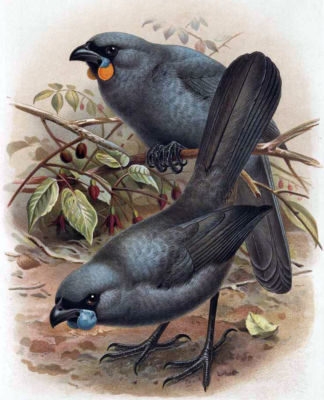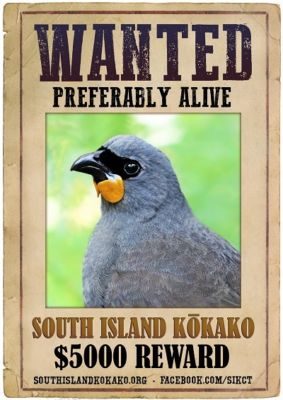Wanted Alive! The South Island kōkako is a bird with a price on its head – $5000 in fact for proof of its existence. So what evidence is there that this distinctive and beautiful bird does survive – and if you wanted to rediscover it, where might you want to go looking?

Back in 2014 Notornis, the journal of the Ornithological Society of New Zealand, published an article by Alec Milne and Richard Stocker, both of Takaka, reviewing evidence for the continued survival of the South Island kōkako. Now might be a profitable and rewarding time to check that article out…
According to the authors, the last accepted report of the SI kōkako was made in 1967 in the Tiel Valley, Mt Aspiring National Park.
“In 2007 the Bird Threat Ranking panel convened by the New Zealand Department of Conservation declared the South Island kōkako extinct… Nevertheless, possible reported sightings continued to be made.”
The article reviews all the 241 reported sightings of the bird between January 1990 and June 2012, including the 13 most compelling sightings which resulted in the bird’s status being changed from ‘extinct’ to ‘data-deficient’ in June 2012. In October 2012, 11 of those 13 compelling sightings were submitted to the Ornithological Society’s ‘Records Appraisal Committee’ (RAC).
“One report, from a March 2007 sighting at Rainy Creek, Reefton, was accepted as a South Island kōkako. Two other reports from March and June 1997 at Waikawa Bay, Queen Charlotte Sound, were considered to be North Island kōkako that were perhaps released in the area. The other 8 submitted reports received either probable or possible assessments.”
According to the authors, a further 23 reports are also considered likely to be kōkako. They have included a map of all reported sightings between January 1990 and June 2012 in their review.
Not all reports of the kōkako were visual. Some reports were of hearing kōkako calls. Of those who did observe a mystery bird at relatively close quarters, descriptions included “lumps of orange around its face”; “pink around its beak” and similar.
“kōkako wattle colour is variable,” say the authors. “While South Island kōkako wattles are reported predominantly to be orange or yellow, often with the basal part blue, reported wattle colours include orange, yellow, orange and blue, blue, red, ‘rich crimson-lake [i.e., reddish purple], the base tinted with violet’ and ‘putty coloured, just a light fawn’. Wattles of nestling South Island kōkako have been reported as ‘rosy pink’, ‘light rose tint, changing to violet towards the base for nearly fledged birds’. Wattle colour of adult North Island kōkako is blue although occasionally orange.”
So if you spot a bird with wattles – take a photograph. You can debate the wattle colour with experts afterwards!
It is not unheard of, even in very recent times, for a supposedly extinct New Zealand bird to be rediscovered. The New Zealand storm petrel was rediscovered in 2003.
Based on the evidence, the authors believe that the South Island kōkako is out there somewhere too. A cluster of reports have been made in the Rainy Creek area near Reefton and these have been mapped in detail in the review article, so if you’re tramping in the area over the summer, it might be worth taking a good camera with you – perhaps even shouldering the additional weight of a powerful telephoto lens in your backpack.
Beware, however, of pollen covered tui:
“There are limited alternate explanations for those category 1 reports where wattles at the base of the bill have been clearly sighted on birds fitting the general description of kōkako. One explanation is that the observers simply ‘got it wrong’… Wattles may have been mistaken, for example, as juvenile tui with pollen-coated faces or blackbirds with Coprosma spp. berries in their bill. Yet this likelihood must be considered low given the proximity and duration of the category 1 sightings…”

And please, don’t be tempted by the $5000 reward to fabricate:
“Fabrication of rare bird sightings is an unfortunate aspect of ornithology in many parts of the world, however the majority of the category 1 observers were unaware of South Island kōkako before their encounter and therefore could not have fabricated their sighting. It is possible that there is another wattled species (rare vagrant) as yet unreported in New Zealand but given the number of category 1 reports, this possibility must also be considered low. We found the most likely explanation for the sightings is that many of them were in fact kōkako”.
The full article is published in Notornis and is freely available on the website of the Ornithological Society of New Zealand:
Check out too, the South Island Kōkako Charitable Trust.

